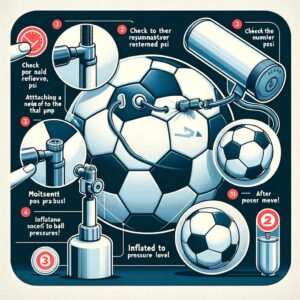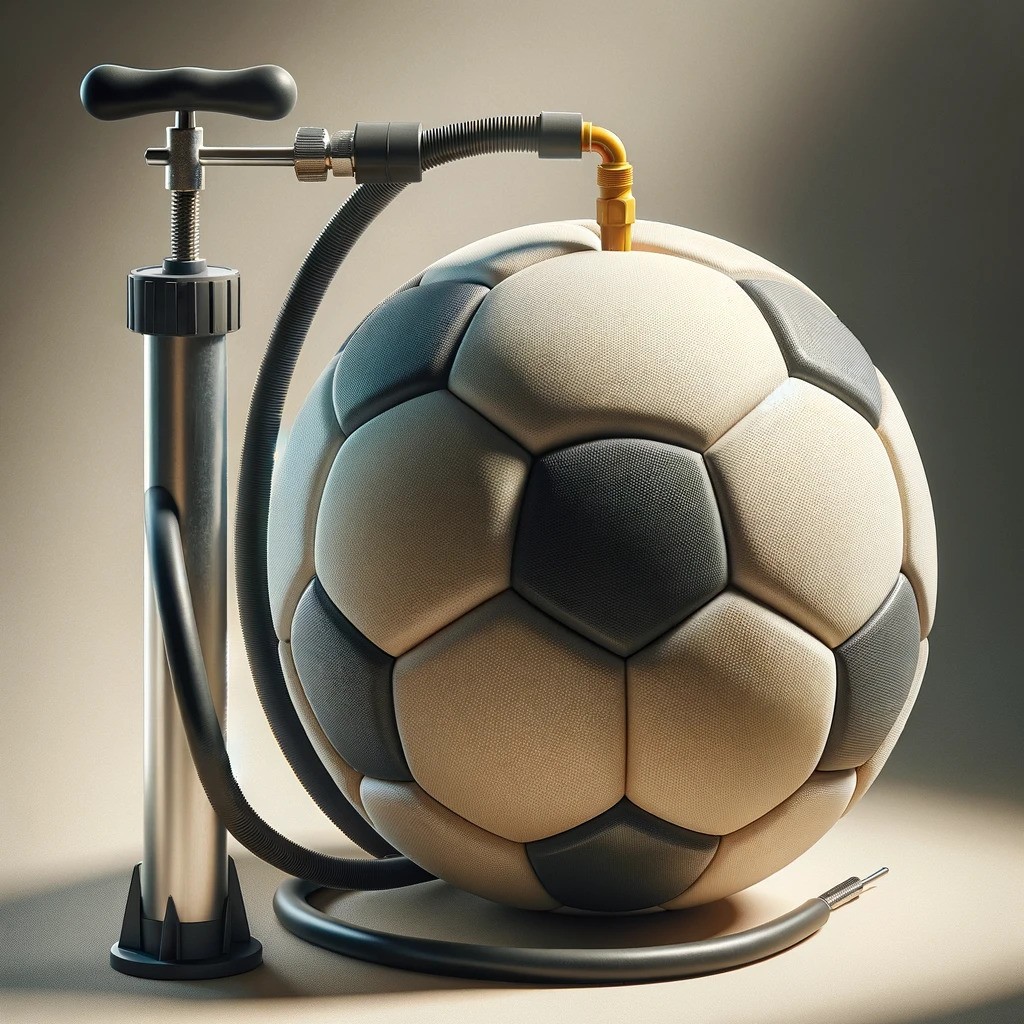A soccer ball at its prime condition is pivotal for the game’s fluidity and the athletes’ performance. The air pressure within a ball not only influences its trajectory, bounce, and speed but also the control players have over it.
Engaging in a match with a deflated soccer ball can significantly hinder the experience, affecting precision, distance, and the overall pace of the game. Moreover, consistently using an under-inflated ball may lead to premature wear and tear, reducing its lifespan and necessitating frequent replacements.
Understanding Soccer Ball Pumps
When it comes to maintaining the optimal air pressure of a soccer ball, the choice of pump plays a crucial role. There are several types of pumps available on the market, each with its own set of advantages.
Manual pumps, electric pumps, and foot pumps are among the most common, with manual pumps being the most portable and economical, electric pumps providing the quickest and least effort-intensive inflation, and foot pumps offering a balance between manual labor and efficiency.
Choosing the right pump involves considering factors such as frequency of use, convenience, and whether the pump will be used in multiple locations or primarily at home.
Step-by-Step Guide to Inflating a Soccer Ball
Step 1: Find the Recommended PSI
- Locate the Recommended PSI: Check the soccer ball for the manufacturer’s recommended PSI (pounds per square inch). This is usually found near the valve or on the packaging. The typical range is between 8.5 to 15.6 PSI for standard soccer balls.
Step 2: Prepare Your Pump and Needle
- Select the Right Pump: Use a hand pump or an electric air pump with a needle attachment designed for soccer balls.
- Lubricate the Needle: Apply a small amount of lubricant (water or saliva works) to the needle to ensure it inserts smoothly into the ball’s valve, reducing the risk of damage.
Step 3: Insert the Needle into the Ball
- Locate the Valve: Find the air valve on the soccer ball. It’s the small, rubber hole typically marked by a different color.
- Insert the Needle Carefully: Gently insert the lubricated needle into the valve. Avoid forcing it in, as this could damage the valve or the bladder of the ball.
Step 4: Inflate the Ball
- Pump Air into the Ball: Start pumping air into the ball. If using a hand pump, steady the ball with your feet or place it on a soft surface to prevent it from rolling away.
- Check Air Pressure: Use the pressure gauge on your pump (if available) or a separate gauge to check the ball’s pressure. Inflate until it reaches the recommended PSI. Avoid over-inflating, as this can distort the shape of the ball or cause it to burst.
Step 5: Remove the Needle
- Release the Needle: Once the ball is inflated to the correct pressure, carefully remove the needle from the valve. Do this slowly to prevent air from escaping too quickly.
- Check the Valve: Ensure the valve closes properly, and no air leaks out after the needle is removed.
Step 6: Perform a Bounce Test
- Check the Bounce: Gently drop the ball from waist height to see if it bounces back up to about knee height. This is a quick test to ensure it’s not over- or under-inflated.
Step 7: Inspect the Ball
- Visual Inspection: Give the ball a once-over to ensure it’s round and there are no bulges indicating over-inflation. The surface should be smooth without any distortions.
Tips for Maintaining Optimal Ball Pressure
- Regular Checks: Air pressure can decrease over time, so check and adjust the pressure before each game.
- Storage: Store the ball in a cool, dry place away from direct sunlight, as extreme temperatures can affect the pressure inside.
By following these detailed steps, your soccer ball will be correctly inflated and maintain its integrity for gameplay. Regular maintenance ensures the longevity of the ball, providing a consistent experience during practice or matches. Happy playing!
How to Properly Inflate a Soccer Ball

Inflating a soccer ball might seem straightforward, but doing it correctly is crucial for the ball’s longevity and performance during play. Start by finding the ball’s recommended PSI (pounds per square inch), which is typically printed near the inflation valve. Over- or under-inflating can affect the ball’s flight and how it feels when kicked.
Steps to Inflate Your Soccer Ball:
- Locate the Valve: Find the valve on the ball and remove any dirt or debris that might obstruct the pump needle.
- Lubricate the Needle: Lightly lubricate the pump needle with some water or saliva to ensure it inserts smoothly without damaging the valve.
- Insert the Needle Carefully: Push the needle into the valve gently until it’s fully inserted.
- Pump to the Recommended PSI: Begin pumping air into the ball, checking the pressure regularly with a gauge to avoid over-inflation.
- Remove the Needle: Once the ball reaches the desired PSI, carefully remove the needle, ensuring not to let too much air escape.
By following these steps, you ensure your soccer ball is inflated for optimal performance, making your game more enjoyable and extending the life of the ball.
Maintenance Tips for Soccer Balls
To ensure your soccer ball remains in top condition, regular maintenance is key. Here are some tips to keep your ball game-ready:
- Regular Inspection: Check your ball before and after games for signs of wear, such as cracks or stitching coming undone. Early detection of damage can prevent further deterioration.
- Clean Regularly: Wipe down your soccer ball with a damp cloth after play, especially if it’s been used on a muddy or dusty field. Avoid using harsh chemicals that can damage the material.
- Store Properly: When not in use, store your ball in a cool, dry place away from direct sunlight. Extreme temperatures and moisture can affect the ball’s shape and performance.
- Rotate Balls: If possible, rotate between multiple balls for practice and games to evenly distribute wear and tear.
These maintenance tips can significantly extend the life of your soccer ball, ensuring it performs well game after game.
Choosing the Right Pump for Your Soccer Ball
Selecting the appropriate pump is as vital as the ball itself. Here are a few things to consider when choosing a pump:
- Type of Pump: Manual pumps are portable and easy to use, making them a great choice for players on the go. Electric pumps fill balls faster and require less effort but are typically more expensive and less portable.
- Needle Quality: Look for pumps with durable, metal needles as they are less likely to break during inflation.
- Pressure Gauge: Opt for a pump with a built-in pressure gauge. This feature is incredibly helpful in inflating your soccer ball to its optimal pressure without guesswork.
Investing in a quality pump ensures your soccer ball is always ready for play, contributing to your overall performance and enjoyment of the game.
The Impact of Air Pressure on Soccer Ball Performance
Air pressure is not just a number; it’s a critical factor that influences how a soccer ball behaves in play. The right amount of air pressure affects the ball’s bounce, speed, and overall control during a game.
Why Air Pressure Matters:
- Bounce: A properly inflated soccer ball will have a consistent and predictable bounce. Too much air pressure and the ball may bounce too high and uncontrollably; too little, and it might not bounce sufficiently.
- Flight: The air pressure inside the ball also affects its flight through the air. Correctly inflated balls will fly straighter and more predictably, which is crucial for accurate passing and shooting.
- Feel: The feel of the ball on your foot is significantly impacted by its air pressure. Players often prefer a certain level of hardness or softness for better control.
To maintain optimal performance, regularly check your soccer ball’s air pressure and adjust it as necessary to match the manufacturer’s recommendations.
How to Fix a Leaky Soccer Ball
Discovering your soccer ball has a leak is disappointing, but not all is lost. With the right tools and a bit of patience, you can often repair a leaky soccer ball and get back to the game.
Steps to Repair a Leak:
- Identify the Leak: Submerge the ball in water and look for bubbles indicating where the air is escaping.
- Dry and Prepare the Area: Once you’ve found the leak, dry the ball thoroughly. Gently sand the area around the leak to help the adhesive bond better.
- Apply Sealant: Use a rubber sealant designed for sports equipment, applying it carefully over the leak. Follow the product’s instructions for drying or curing times.
- Reinflate and Test: After the sealant has dried, slowly reinflate the ball to its recommended pressure. Submerge it again in water to ensure the leak has been sealed.
This method can extend your soccer ball’s life, but it’s important to consider that a repaired ball may not perform as well as a new one in competitive play.
Conclusion
In the world of soccer, the condition of the ball plays a pivotal role in the quality of play and the overall experience. From understanding how to properly inflate a soccer ball to recognizing the impact of air pressure on performance, we’ve covered essential aspects to ensure your soccer ball remains in top condition. Maintenance tips and choosing the right pump are crucial for longevity, while knowledge on fixing a leaky ball can save the day and extend your ball’s life.
Frequently Asked Questions
Can you deflate a soccer ball with a pump?
Yes, you can deflate a soccer ball with a pump by using the pump’s needle without attaching it to the pump body. Insert the needle into the ball’s valve to let the air out. This method is helpful for storage or transport.
How many pumps does it take to explode a soccer ball?
The number of pumps required to explode a soccer ball varies based on the pump’s efficiency and the ball’s quality. However, it’s crucial to monitor the ball’s PSI during inflation to prevent over-inflation. Most balls are designed to withstand pressure well above their recommended PSI, but excessive pumping can damage or burst the ball.
How do you use an air pump for a soccer ball?
To use an air pump for a soccer ball, lubricate the pump needle and insert it into the ball’s valve. Pump air until the ball reaches its recommended PSI, checking the pressure with a gauge. Carefully remove the needle to avoid air loss, ensuring the ball is properly inflated.
What to do with deflated soccer ball?
If you find a soccer ball deflated, inspect it for leaks or damage. If it’s simply low on air, use a pump with a needle attachment to inflate it to the recommended PSI. For balls with leaks, consider attempting a repair with a sealant or patch kit designed for sports equipment.
Should you pump a soccer ball?
Yes, you should pump a soccer ball to ensure it maintains the recommended PSI for optimal performance. Regularly check and adjust the air pressure to keep the ball in good condition, providing a consistent playing experience.
Is it easier to kick a deflated soccer ball?
Kicking a deflated soccer ball may require less force, but it significantly reduces accuracy, control, and the distance the ball can travel. An adequately inflated ball ensures a better game experience, allowing for precise passes, shots, and overall playability.

